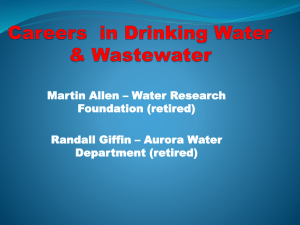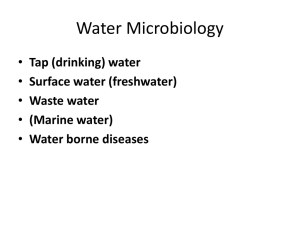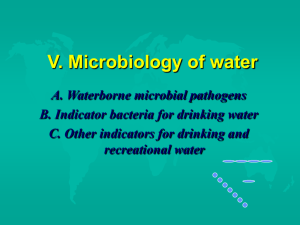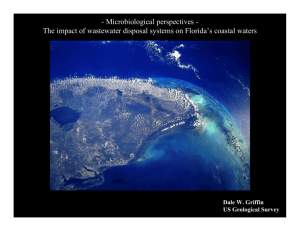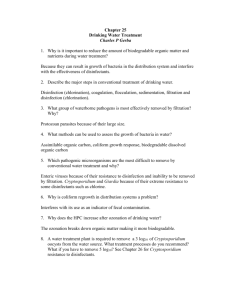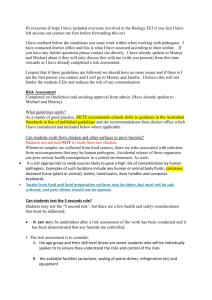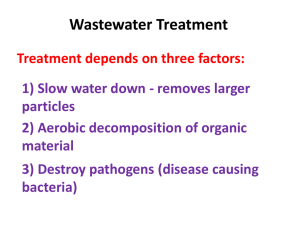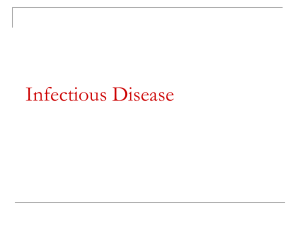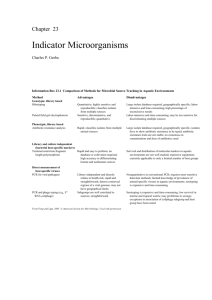notes
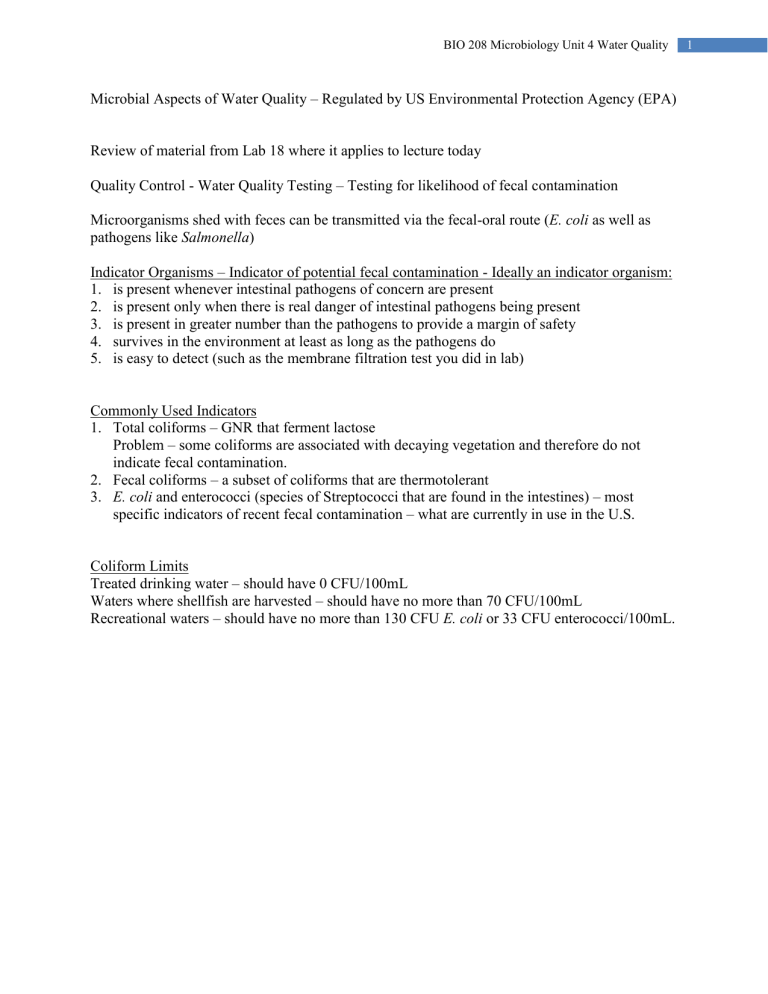
BIO 208 Microbiology Unit 4 Water Quality 1
Microbial Aspects of Water Quality – Regulated by US Environmental Protection Agency (EPA)
Review of material from Lab 18 where it applies to lecture today
Quality Control - Water Quality Testing – Testing for likelihood of fecal contamination
Microorganisms shed with feces can be transmitted via the fecal-oral route ( E. coli as well as pathogens like Salmonella )
Indicator Organisms – Indicator of potential fecal contamination - Ideally an indicator organism:
1.
is present whenever intestinal pathogens of concern are present
2.
is present only when there is real danger of intestinal pathogens being present
3.
is present in greater number than the pathogens to provide a margin of safety
4.
survives in the environment at least as long as the pathogens do
5.
is easy to detect (such as the membrane filtration test you did in lab)
Commonly Used Indicators
1.
Total coliforms – GNR that ferment lactose
Problem – some coliforms are associated with decaying vegetation and therefore do not indicate fecal contamination.
2.
Fecal coliforms – a subset of coliforms that are thermotolerant
3.
E. coli and enterococci (species of Streptococci that are found in the intestines) – most specific indicators of recent fecal contamination – what are currently in use in the U.S.
Coliform Limits
Treated drinking water – should have 0 CFU/100mL
Waters where shellfish are harvested – should have no more than 70 CFU/100mL
Recreational waters – should have no more than 130 CFU E. coli or 33 CFU enterococci/100mL.
BIO 208 Microbiology Unit 4 Water Quality 2
I. Wastewater Treatment
Wastewater – comes from domestic or industrial effluents (effluent is the outpouring of water)
Domestic H
2
O = black H
2
O + gray H
2
O
Q. Why does wastewater need to be treated?
A. Because it is:
1. high in nutrients -
2. high in BOD (Biological Oxygen Demand) -
3. contaminated with disease causing (pathogenic) microorganisms
What are the goals of wastewater treatment
1. remove organic compounds
2. eliminate pathogens
Q. What happens to domestic wastewater?
A. Wastewater treatment consists of a combination of physical and biological processes
1.
Primary – physical - screen out large junk, settle
sludge + liquid
2.
Secondary – microbial -
nutrient load,
organics (
BOD)
Liquid – aerobic aerobic respirers
(heterotrophs + chemoautotrophs)
Sludge – anaerobic fermenters and anaerobic respirers
Oxidation of complex organics
CO
2
Disinfect with chlorine, aerate,
QC (count E. coli in water using e.g., membrane filtration like you did in lab) discharge to body of water.
Fermentation of complex organics
CO
2
+ CH
Remaining solids – land application as fertilizer
4
BIO 208 Microbiology Unit 4 Water Quality 3
II. Drinking Water Treatment
Goals of Drinking Water Treatment
1. decrease turbidity
2. eliminate taste and odor
3. reduce chemicals
4. remove potentially pathogenic microbes
In the US, drinking water usually comes from aquifers (groundwater) or lakes, rivers, and reservoirs (surface water)
Steps in a Typical Water Treatment Facility
1. Source – water from source moves to a sedimentation basin where sand and gravel are removed. Turbidity will be decreased (clarity improves)
2. Clarify – water moves next to a clarifier where chemicals are added to create a “floc”. Flocs trap microorganisms and organic matter, and because they are heavy, they settle. Turbidity is decreased even more (clarity improves more).
3. Filter – clarified water is filtered to remove the flocs containing organics and particles including microorganisms.
4. Disinfect- to kill any remaining microorganisms - chlorination is most common disinfectant of treated water, kills most microbes w/in 30 min. (some communities use ozone).
Problems w/ chlorination
–
residual chlorine in water can combine with organics to form carcinogens
cysts of protozoan pathogens like Giardia and Cryptosopridium are not affected by , can survive chlorination, and then drinking water with these cysts leads to illness.
5. Quality control (QC) – determine counts of coliform bacteria remaining in the treated drinking water (must be 0 CFU/100mL)
6. Distribute – out to consumers through the local water distribution pipe system.
BIO 208 Microbiology Unit 4 Water Quality 4
III. Protection of Great Lakes Recreational Water
The Great Lakes have more than 10,000 miles of coastline
Michigan has over 3,200 miles of coastline
The Michigan coastline has 454 public access beaches
Fecal material gets into recreational water
1. sewage discharges (accidental and illicit)
2. urban and agricultural runoff
3. wildlife
4. humans
Human source fecal contamination is “high risk” because much more likely to contain microorganisms that will make humans sick.
In Michigan, beach quality is regulated by the Department of Environmental Quality (MDEQ).
The threshold is 130 CFU of E. coli per 100mL of swimming water – if thresholds are exceeded, swim advisories may be posted or beaches closed.
